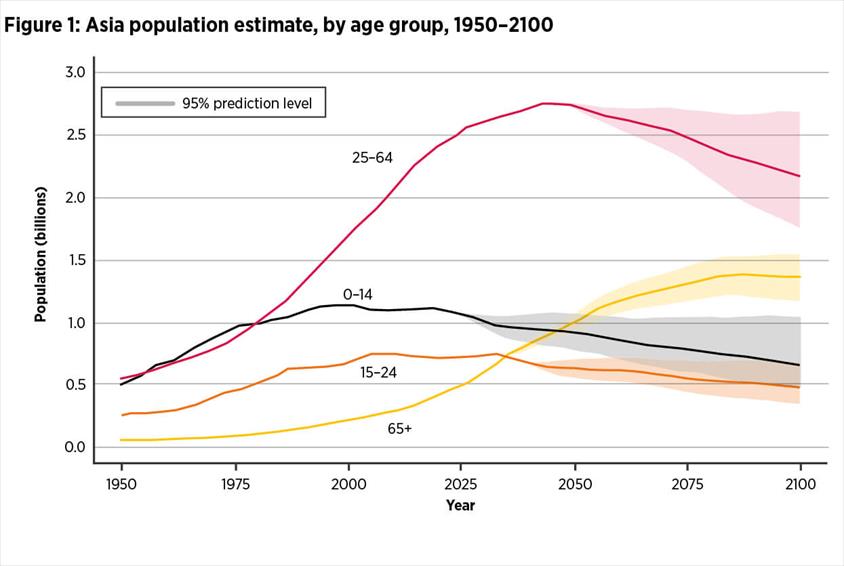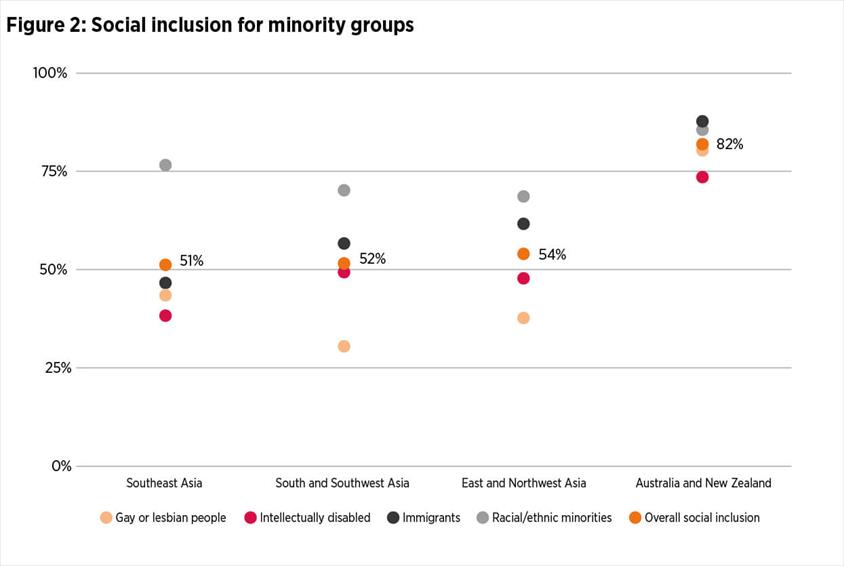Since 1950, the world’s population has increased each year, and by November 2022, it was estimated to reach 8 billion people. However, demographic data suggests that the working-age population (15–64-year-olds) will slowly decrease through to 2040, meaning that talent pools and the number of workers are shrinking.
Businesses will be faced with a labour drought that will only be exacerbated by decreasing fertility rates, ageing populations and declining immigration (Lightcast 2022). However, the picture looks very different in the Asia-Pacific region. We draw on two case studies to show the impact of demographic change over the next 30 years on one developing nation (Bangladesh) and one developed nation (Japan).
Asia-Pacific case study
There are an estimated 4.9 billion people in Asia-Pacific, which accounts for 63% of the world’s population. This region has the largest population globally, predominantly due to China and India.
In terms of the population composition, the Asia-Pacific region has an estimated:
- 730 million young people (15–24-year-olds)
- 3.2 billion working-age people (15–64-year-olds)
- 460 million elderly people (65 years or older).
As shown in Figure 1, it’s estimated that the region will reach its highest number of working-age population in the next 20 years. The elderly population will outnumber the youth population in the next 30 years.

Source: World Population Prospects 2022.
So, what do these figures mean for the future workforce?
Opportunities to raise workforce diversity
Having the largest population of young people in history offers many opportunities to benefit from a ‘demographic dividend’. This is when a country has a large working-age population compared with the non-working-age populations (for example, those aged under 14 and those aged over 65). Countries with the greatest demographic opportunity for development are those entering a period in which the working-age population has good health, quality education, employment opportunities and a lower proportion of young dependants. When this happens, the national economic payoff can be substantial. Predictions suggest that many countries in Asia are entering a demographic dividend period over the next 25 years, providing an opportunity to develop their workforce and improve productivity.
Using the examples of Bangladesh and Japan – two countries transitioning to a more mature population – we can look at the potential impact and opportunities within a developing and developed country.
Bangladesh: population growth leading to a surplus working-age population
In 2022, Bangladesh has a total population of 164 million – with an estimated 65% of working age. Its working-age population is estimated to continue increasing until 2050. Although the country’s birth rate started declining sharply in the 1970s, the total population will continue growing until 2060, when it is estimated to start to decline. The country is ageing fast, and the population aged 65 years and older will increase from 7% in 2030 to 16% in 2050.
These changes present Bangladesh, and organisations operating in this region, with a window of opportunity from 2022 to 2050. As well as a growing working-age population, we’ve seen some positive trends in female workers. Historically, Bangladesh has had a low female workforce participation rate; however, we’ve seen an increase of female workers from 30% in 1990 to 44% in 2021. The number of women completing secondary education has increased from 29% in 2011 to 50% in 2020. Policy-makers and senior leaders of businesses should focus on attracting, recruiting and developing more women at all levels, to capitalise on this growing availability of talent. This will increase the number of women in more senior positions and lead to greater gender diversity across the workforce.
Japan: addressing population decline and ageing
In 2022, Japan has a total population of 125 million – with an estimated 54% of working age. Japan has the world’s oldest population, which is decreasing at an accelerating rate. About 29% of its total population are 65 years or older, with a higher proportion of this group being women. In 2000, Japan reached its highest number of people of working age (55 million). This sharply decreased to 43 million in 2020, which is a 2.4% decline per year. Impacting this are two factors: Japan’s low birth rate and immigrating to Japan being difficult. The ‘silver economy’ policy in Japan aims to address a rapidly ageing population (and workforce) in Japan by:
- improving human capital at all ages by ensuring that workforces have the required skills and education needed in the current job market
- enhancing employment benefits, including health and social support services during and after employment
- closing the gender gap in education and employment so more women and girls can become productive workforce members
- providing older people with more job opportunities
- ensuring a healthy life into old age, aiming to increase income and social security in old age.
A healthy labour force and increased employment opportunities are key to maximising their ‘silver dividend’.
What are the potential barriers to increasing workforce diversity?
1. The impact of traditional social norms
While some aspects of society in Asia are undergoing major changes, other dimensions have been resistant, reinforcing traditional norms. Figure 2 shows survey data highlighting attitudes across the Asia-Pacific region towards four social groups: racial or ethnic minorities, immigrants, people living with disabilities, and gender minorities. These results highlight how some regions continue to hold social beliefs that are discriminatory towards certain groups. For example, South-East Asia is relatively positive towards racial and ethnic minorities, but less tolerant towards immigrants, people living with a disability, and lesbian, bisexual, gay, transgender and queer+ (LBGTQ+) people. Compared with regional leaders Australia and New Zealand, the rest of the region still lags far behind, by around 30% in terms of average inclusion level of the four minority groups above.

Note: Percentage of respondents reporting favourable attitudes towards people of the selected minority group. Overall social inclusion is an average of responses to four groups.
Source: Gallup World Poll
2. Social norms and women in employment
In the Asia-Pacific region, social norms and values can have a negative impact on women, in terms of educational opportunities and gaining employment. They reinforce traditional expectations of women remaining the main caregivers of children and the elderly, resulting in women having lower levels of education and earning less than men.1 Even in more developed countries, there are examples of discriminatory laws or practices, for example in Japan and Korea, where women are regularly asked in job interviews whether they plan to have a family in the future.2
However, change is on the horizon. Within the last two years, 65 countries have implemented 100 legal reforms aimed at increasing women’s economic opportunities. But more changes are needed, especially given that half of the countries in Asia do not have any laws that protect against gender discrimination in the workplace. Only six countries have laws that are intended to close gender pay gaps: Australia, Kiribati, Samoa, the Philippines, Vietnam and Bhutan, so there is certainly more to be done in the region.3
Key takeaways
These findings are globally significant. Business leaders need to look ahead, and use insights derived from data to anticipate demographic shifts. They should address talent gaps by investing in and creating employment opportunities for those entering the workforce. Here are six key takeaways to consider:
- Create easier entry pathways into your business: identify available talent, and how your business can attract and support these individuals into your workforce.
- Tailor your approach based on the employee lifecycle: transitioning and onboarding entry-level employees will require a different approach from onboarding older workers.
- Ensure upskilling programmes support all workers: learning and development needs will vary hugely. Understand the skills gaps and development needs of individuals.
- Think about equality and fairness: how can your business ensure work is good for the entire workforce? Employee expectations and employee relations continually change, so make sure your business is listening to its employees and adapt where needed.
- Provide workforce opportunities for those who are left furthest behind: review how you recruit and retain your employees to ensure your business provides inclusive employment opportunities.
- Be evidence-based in your approach: before you act, use the best available evidence to make better decisions about your workforce.
How is demographic change affecting other regions?
MENA has the largest youth population in the world and the highest youth unemployment rate, especially within women - making gender diversity an economic and business imperative.
The UK is experiencing a post-pandemic trend of older workers becoming economically inactive - two thirs of this can be explained by population profile changes.
With more than half of 25-64-year-olds having higher education qualifications, we've seen increased productivity and job quality, resulting in high economic growth rates post-pandemic.
About the author
Björn Andersson, Regional Director for UNFPA, Asia-Pacific
Prior to this role, Björn served as Chief of Staff to two Executive Directors of UNFPA. He has almost three decades of extensive experience in international development cooperation, with key positions in programme management, policy development and strategic organisational management within the UN system and government agencies, including as Director of the Department for Development Policy at the Ministry for Foreign Affairs of Sweden between 2008 and 2013.
CIPD Trust
Tackling barriers to work today whilst creating inclusive workplaces of tomorrow.
Bullying
and harassment
Discover our practice guidance and recommendations to tackle bullying and harassment in the workplace.

Explore the CIPD’s point of view on religion and belief, including actions for Government and recommendations for employers

Explore the CIPD’s point of view on age diversity in the workplace, including recommendations for employers and actions for the UK Government

Explore the CIPD’s point of view on gender equality at work, including recommendations for employers and actions for the UK Government

Explore the CIPD’s point of view on sexual orientation, gender identity and gender reassignment, including recommendations for employers

Peter Cheese, the CIPD's chief executive, looks at the challenges and opportunities faced by today’s business leaders and the strategic priorities needed to drive future success

We outline the key pieces of legislation set to come into force in the UK and explain their implications for employers and employees

We examine people’s desired hours and how this compares to the hours they actually work

Employers’ reactions to pension proposal highlight concerns over cost, while the CIPD calls for focus on raising pension awareness among staff, the need for higher contributions and better understanding of value for money


